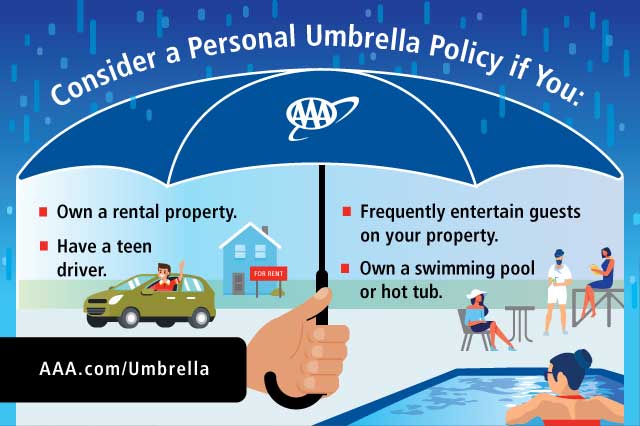

Unfortunately, even nice guys get unlucky sometimes.
UMBRELLA POLICIES DRIVER
The chances of me getting sued for over $500,000 are slim because: 1) I’ve got to be found negligent in the accident, 2) I’ve got to create massive damage in the accident, 3) The victim needs to go through the process of suing, 4) The victim needs to win, 5) Cases are usually settled out of court for less, 6) I drive half the national average, 7) I’m a pretty careful driver with a slow car, and 8) I’m a nice guy! However, you don’t need to get an umbrella policy to cover your entire net worth if you do not wish. Because I have assets well over $500,000, I elected to get an umbrella policy to cover the rest of my estimated net worth. I could get more liability, but the increase in premiums would make my insurance less worthwhile. My auto insurance policy has a maximum $500,000 liability per accident. If you are the person with the Porsche, you probably want to get an umbrella policy.Īuto insurance policies only cover so much. However, if someone in a 1985 Honda Civic runs you over, you may think getting financial remedy is not worth it. If someone in a $230,000 Porsche 911 Turbo runs you over after running a red light, you’re probably more inclined to hire a lawyer and sue for big bucks. Let me share an example of how an umbrella policy can protect the policy holder. When you’ve spent a lifetime building assets for your retirement, the last thing you want is to get sued for all you’re worth! Accidents happen all the time and the more you are worth, the more the injured person may go after your assets. This article will specifically describe how does an umbrella policy work and how much does it cost. An umbrella policy is also known as a personal liability insurance (PLU). I’d like to now talk about whether you should get an umbrella policy. File Inspection-Scan and inspect files for malicious content hosted on risky domains before those files are downloaded.We’ve talked about all the different types of auto insurance.Block Pages-Allows you to configure the web page users see when an attempt is made to reach a blocked destination.Destination Lists-Allows you to create a unique list of destinations (for example, domain name or URL) to which you can block or allow access.For example, Netflix, Facebook, or Amazon. Application Settings-Allows you to block access to specific applications.For example, sports, gambling, or astrology. Content Categories-Allows you to block access to categories of websites-groupings of sites with similarly themed content.Security Settings-Allows you to select which security threat categories Umbrella blocks.The Policy wizard includes many and varied access control and security-related components for you to consider when defining policies for your identities. Once the new policy is saved, it may take upwards of five minutes for the policy to replicate through Umbrella’s global infrastructure and start taking effect. These components are made available as steps in the wizard. In the second part of the wizard, you configure each component of the policy that was selected in part one of the wizard. In the first part of the wizard, you choose the identities to which the policy applies and which components should be enabled and configured for the policy. You create policies through the Policy wizard, which is made up of two parts. Thus, the Default policy is a catch-all to ensure that all identities within your organization receive at least a minimum of Umbrella protection. The Default policy is applied to an identity when no other policy matches that identity. This Default policy applies to all identities and cannot be deleted-you can, however, configure it to meet your organization's unique requirements. There is always at least one policy-the Default policy. For some helpful suggestions, see Best Practices for Policy Creation. Plan and design your policies before you build them. An error in configuration may result in unintended results: identities being left unprotected to various threats or users accessing destinations you may want blocked.

Because of the way Umbrella evaluates identities against policies, it's important that you configure policies correctly for each of your organization's identities. If no matching policy is found, Umbrella applies the Default policy. However, Umbrella applies the first matching policy to your identity and immediately stops evaluating policies. You can have more than one policy and your identities can be added to any number of policies.


 0 kommentar(er)
0 kommentar(er)
